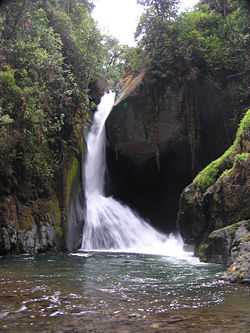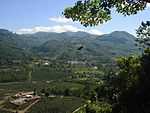Spanish 1/Chapter 10 (Family & Celebrations)
< Spanish 1Chapter 10 (Family & Celebrations)
Family members
- abuelos - grandparents
- abuelo - grandfather
- abuela - grandmother
- esposo - husband
- esposa - wife
- hermanos - siblings, brothers
- hermano - brother
- hermana - sister
- hermanastro - stepbrother
- hermanastra - stepsister
- hijos - children, sons
- hijo - son
- hija - daughter
- padres - parents
- padre (papá) - father
- madre (mamá) - mother
- padrastro - stepfather
- madrastra - stepmother
- primos - cousins
- primo - male cousin
- prima - female cousin
- tíos - uncles & aunts, uncles
- tío - uncle
- tía - aunts
Note: Spanish-speaking people use papá and mamá when calling their own parents. Spanish-speakers also use the suffixes -ito or ita to show affection, for example almost all Spanish speakers call their grandparents, abuelito and abuelita to show affection.
Age
- ¿Cuántos años tiene(n) ... ? - How old is/are ... ?
- Tiene(n) ... años. - He/She is/They are ... (years old)
- mayor - older
- menor - younger
People
- persona - person
Pets
- gato - cat
- perro - dog
To talk about what someone enjoys
- (a + person) le gusta(n) - he/she likes
- (a + person) le encanta(n) - he/she loves
Note: The a placed before the person's name is called the personal a and is used to respect that person when talking.
Verbs to describe parties
- abrir - to open
- celebrar - to celebrate
- decorar - to decorate
- decoraciones - decorations
- hacer un video - to videotape
- video - video
- preparar - to prepare
- romper - to break
- sacar fotos - to take pictures
- foto - photo
Items at a party
- cámara - camera
- cumpleaños - birthday
- ¡Feliz cumpleaños! - Happy birthday!
- dulces - candy
- flor - flower
- globo - balloon
- luz - light
- papel picado - cut-paper decorations
- pastel - cake
- piñata - piñata
- regalo - gift, present
Other words
- que - who, that
- sólo - only
Tener (to have)
In Spanish, the word tener means to have. Like ir and jugar it conjugates irregularly, and like jugar, its stem changes when conjugated except in the nosotros(as) and vosotros(as) forms, e becomes ie. Tener is also unique because the yo conjugation is irregular from all the others (Tener is not unique in this respect, i.e poner - yo pongo).
- tengo - I have
- tienes - you have (singular)
- tiene - he/she has
- tenemos - we have
- tenéis - you have (plural)
- tienen - they have
Note: Did you remember that usted (Ud.) and ustedes (Uds.) use the 3rd person conjugation form?
Possessive adjectives
Possessive adjectives talk about the ownership of something. They are similar to other adjectives in Spanish that must agree with number and gender.
- mi(s) - my
- tu(s) - your
- su(s) - your (formal), his, her, its
- nuestro(s), -a(s) - our
- vuestro(s), -a(s) - your (plural)
- su(s) - your (plural/formal), their
Vocabulario adicional
- bisabuelo - great-grandfather
- bisabuela - great-grandmother
- nieto - grandson
- nieta - granddaughter
- sobrino - nephew
- sobrina - niece
- conejillo de Indias - guinea pig
- conejo - rabbit
- gerbo - gerbil
- hámster - hamster
- hurón - ferret
- loro - parrot
- pez - fish
- serpiente - snake
- tortuga - turtle
- hijo(a) único(a) - only child
Note: Use pez to refer to an alive fish and pescado to refer to a dead fish.
Cultural Insight (Papel picado)
Papel picado is the Mexican art of papercutting into elaborate designs. The designs are commonly cut from tissue paper using a guide and small chisels, creating as many as forty banners at a time. Common themes includes birds, floral designs, and skeletons. They are commonly displayed for Easter, Christmas, and the Day of the Dead, as well as during weddings, quinceañeras and christenings. Papel picado can also be made by folding the tissue paper and using small, sharp scissors.
Country Focus (Costa Rica)
.svg.png)

Costa Rica (Spanish: Costa Rica) is a republic in Central America, bordered by Nicaragua to the north, Panama to the east-southeast, the Pacific Ocean to the west and south, and the Caribbean Sea to the east. Costa Rica was the first country in the world to constitutionally abolish its army. Among Latin American countries, Costa Rica ranks 6th in terms of the 2009 Human Development Index, and 54th worldwide. Costa Rica is ranked 5th in the world in terms of the 2008 Environmental Performance Index, up from the 15th place in 2006. In 2007 the government of Costa Rica stated that they want to be the first country to become carbon neutral by 2021. Costa Rica is home to a rich variety of plants and animals. While the country has only about 0.1% of the world's landmass, it contains 5% of the world's biodiversity.

Costa Rica boasts a varied history. Costa Rica was the point where the Mesoamerican and South American native cultures met. The northwest of the country, the Nicoya peninsula, was the southernmost point of Nahuatl cultural influence when the Spanish conquerors (conquistadores) came in the sixteenth century. The center and southern portions of the country had Chibcha influences.
Factbox:
-Official Languages: Spanish
-Other Languages: English, Native American languages, English Creole languages
-Capital: San José
-Government: Democracy

-Area: 51,100 sq km (19,730 sq mi) (129th)
-Population: 4,468,000 (118th)
-Religion: Christianity (Catholic 76.3%, Protestant 14.4%, Jehovah's Witnesses 1.3%) 92.4%, Non-religious 3.2%, Buddhism 2.34%, other (Judaism, Islam, Animism, Bahá'i, Hindu) 2.06%
-Human Development: 0.854 (54th, HIGH)
-Independence: September 15, 1821
-Currency: Costa Rican colón